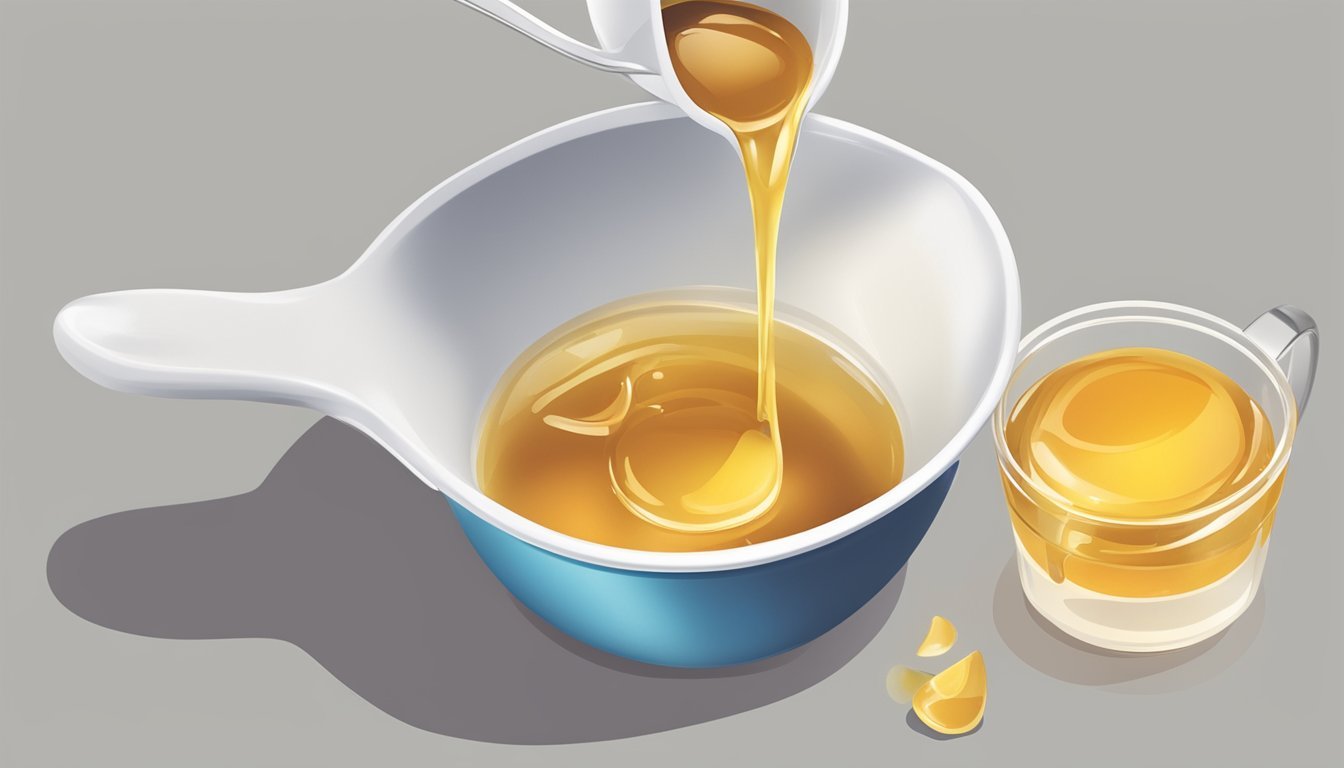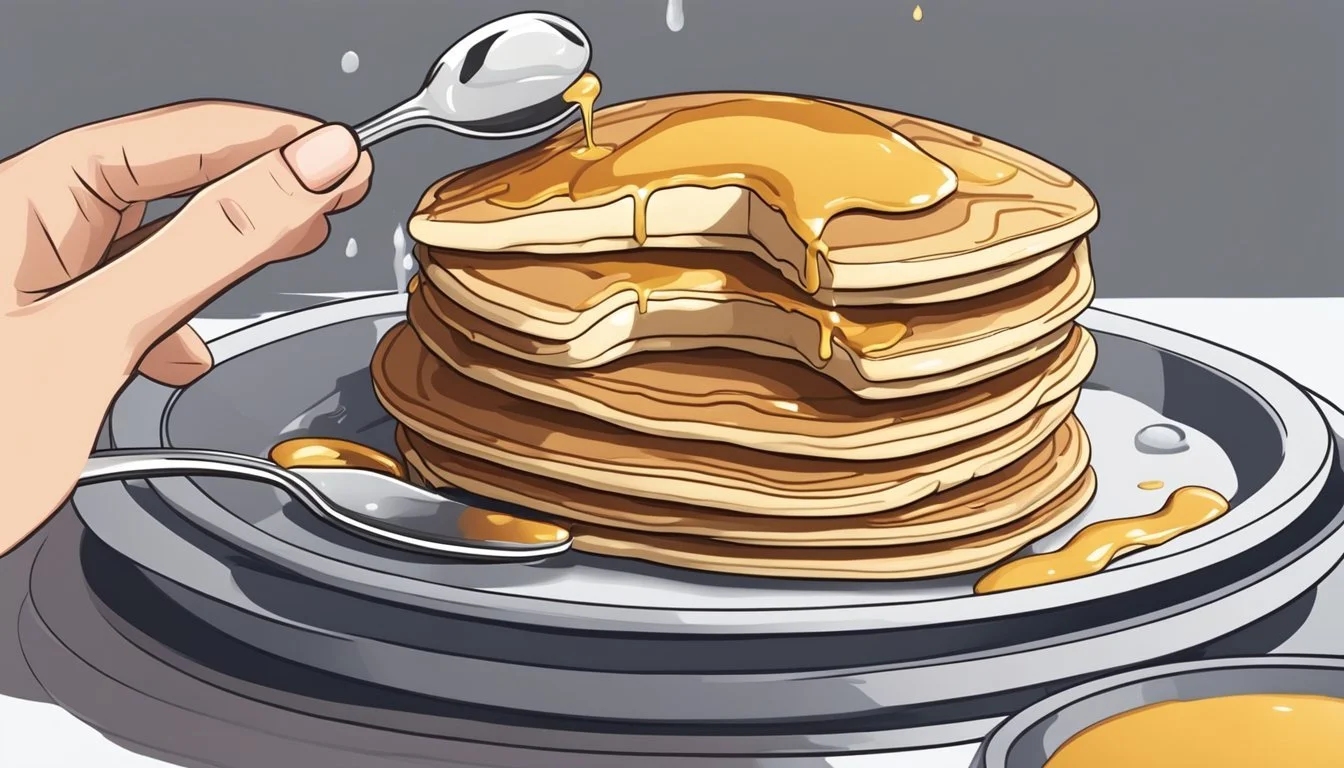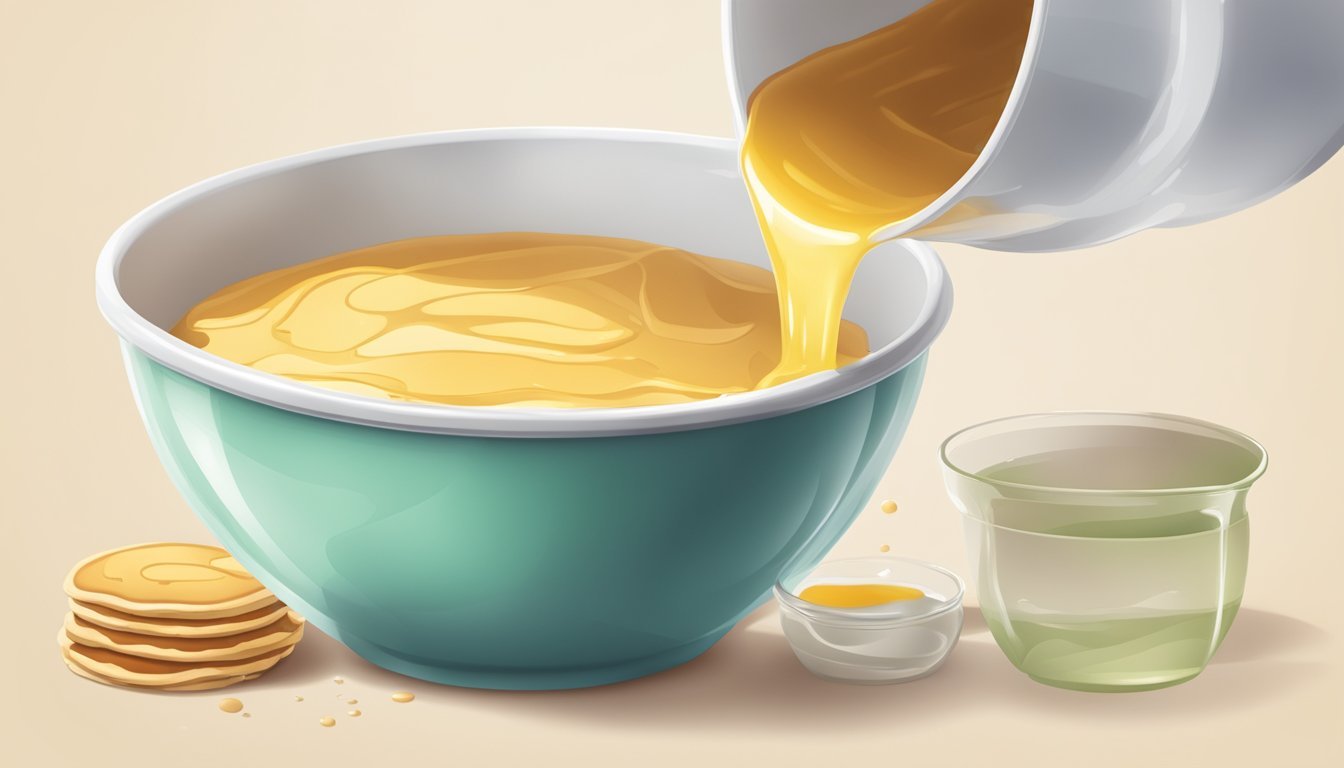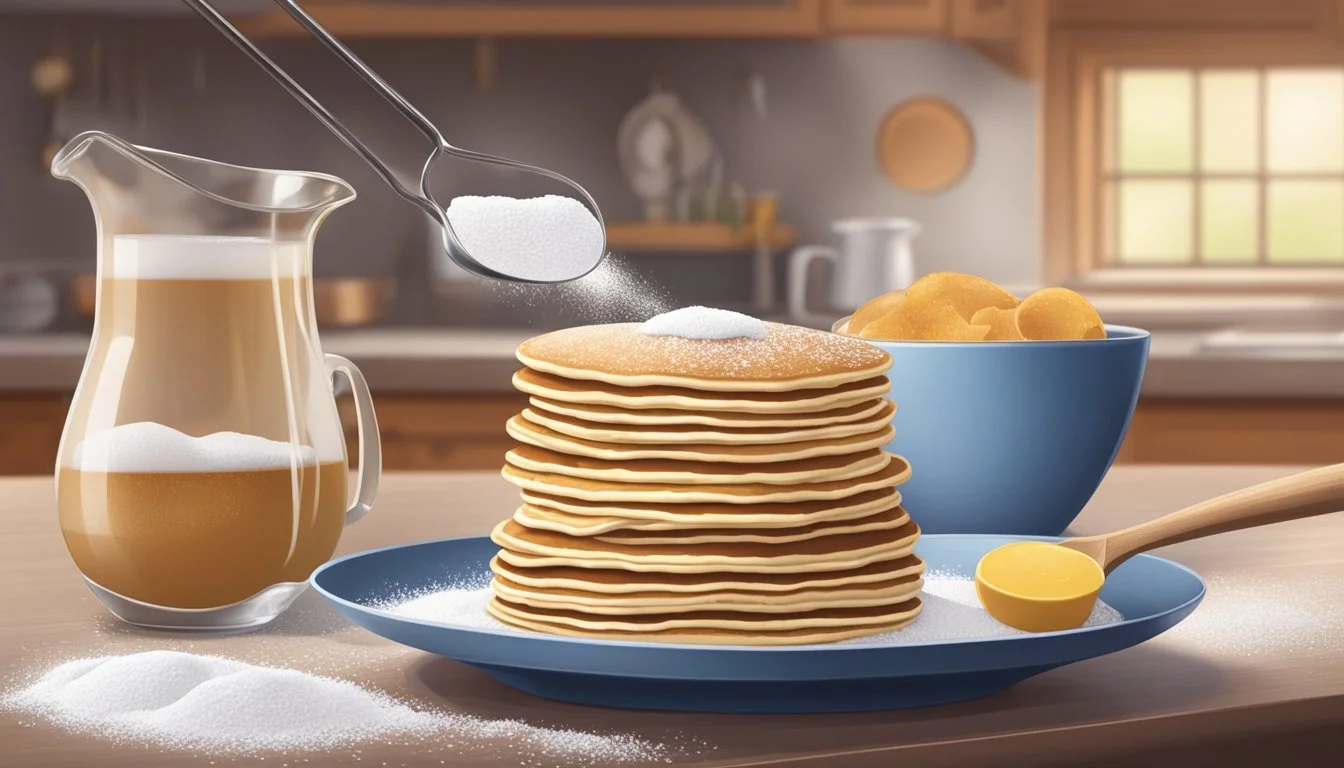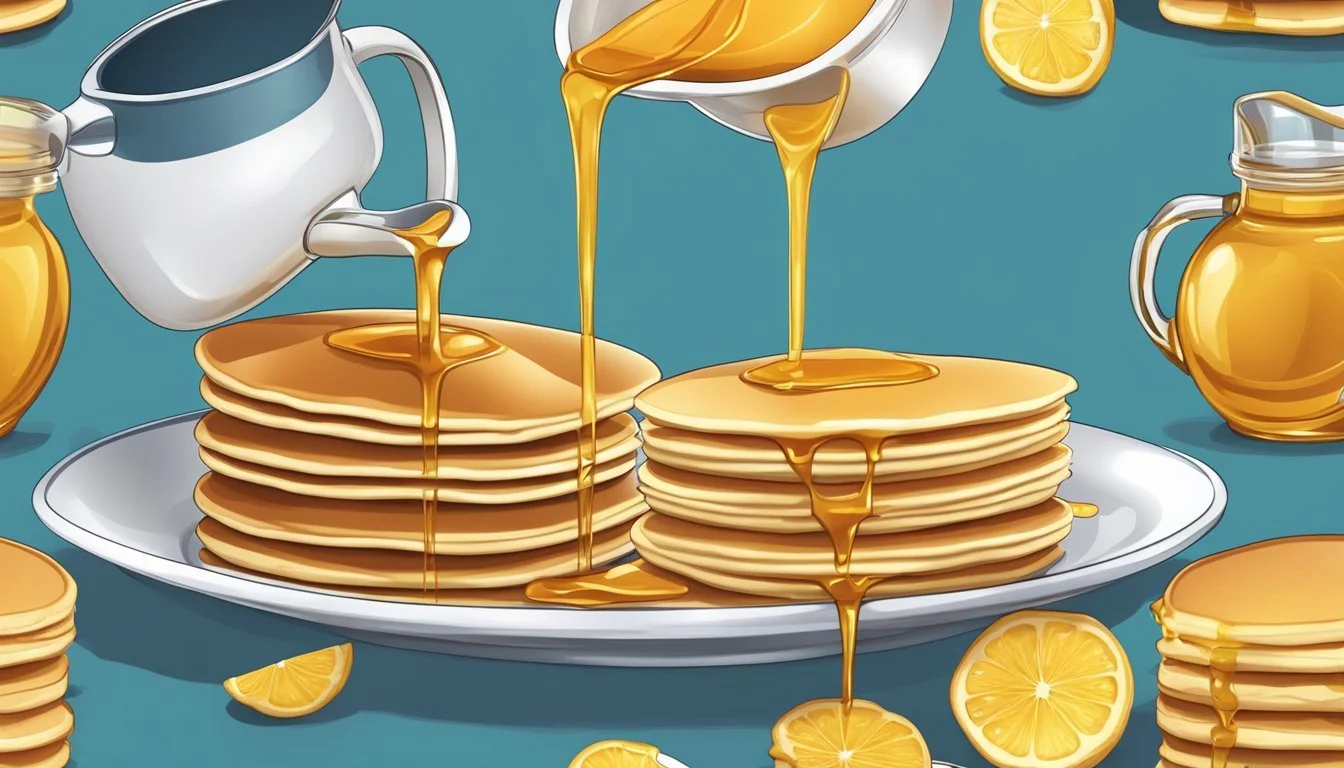How to Measure the Perfect Amount of Liquid for a Pancake Glaze
Precision Pouring Tips
Achieving the perfect consistency for a pancake glaze can elevate a simple breakfast to a memorable meal. Glazes are an integral part of the pancake experience, not only adding flavor but also contributing to the nutrition of the dish, allowing for a balance between indulgence and health. Whether one opts for a classic cream cheese glaze or a more innovative topping, the paramount factor is the precise measurement of liquid ingredients to ensure the glaze is neither too runny nor too thick.
The art of preparing the ideal pancake glaze begins with a fundamental understanding of the ingredients. Liquids, typically in the form of milk or cream, must be added gradually to the base of powdered sugar and flavorings like vanilla or almond extract. The nutritional content of these liquids can vary, with options like almond milk offering a lower-calorie alternative to traditional dairy.
To master the technique, one must consider the desired final texture of the glaze, which should pour smoothly without losing its rich, creamy body. It's important to adjust the liquid incrementally, mindful of the fact that it's far simpler to thin a thick glaze than to correct one that’s overly diluted. This attention to detail ensures a glaze that enhances the taste and appeal of pancakes, contributing to a balanced and nutritious breakfast.
Understanding the Basics of Pancake Glaze
Creating the perfect pancake glaze hinges on understanding the ideal consistency for spreading and the selection of ingredients that contribute to texture, flavor, and stability.
Importance of Consistency
The consistency of the pancake glaze determines its texture and how well it coats the pancakes. A glaze that is too thick might clump and not spread evenly, while one that is too thin will run off the sides and not adhere properly. To measure the perfect amount of liquid, one must consider the ratio of liquid to dry ingredients. A common starting point for a cream cheese glaze, for instance, can be a 1:2 ratio of milk to powdered sugar. Adjustments should be made based on the glaze's performance during a test spread, aiming for a silky, pourable texture that stays atop pancakes without dripping excessively.
Selecting the Right Ingredients
The choice of ingredients has a direct impact on the glaze's flavor and structure. Start with sugar, typically powdered or confectioners' for smoothness. Butter adds richness but must be balanced to avoid greasiness. Milk — or cream for a thicker glaze — provides the liquid base and should be introduced gradually. When used, cream cheese must be at room temperature for seamless integration. As the ingredients are mixed, the recipe may call for adjustments. For example, more milk can thin a glaze, while extra sugar can thicken it.
Ingredient Measurements and Ratios
Accurate ingredient measurements and ratios are crucial for crafting the perfect pancake glaze, which both complements and enhances the flavor of the pancake.
Liquid Ingredients for Glaze
For a basic pancake glaze, the chef often begins with milk or cream to provide a creamy consistency. The exact amount will depend on the desired thickness, but a starting ratio might be 4 tablespoons of milk for every 1 cup of powdered sugar. If extending the recipe, a liquid measuring cup should be used, ensuring to check the measurement at eye level for precision. For those opting for a richer glaze, substituting milk with cream cheese can provide a thicker texture and a tangy flavor profile.
Example Proportions for Cream Cheese Glaze:
2 ounces of cream cheese
4 tablespoons of butter
1 cup of powdered sugar
1 teaspoon of vanilla extract (optional)
2-4 tablespoons of milk (as needed for consistency)
Balancing Sweetness and Flavor
While sugar is a primary component in a pancake glaze, balancing the sweetness with flavors that augment the tasting experience is essential. For instance, vanilla extract or citrus zest can add depth. The preferred ratio for sugar to flavor is generally up to the chef’s preference, but a helpful guideline might be 1/4 teaspoon of vanilla extract for every 1 cup of powdered sugar used. Salt can also be used to contrast the sweetness and should be measured with care; a pinch, typically less than 1/8 teaspoon, is often sufficient.
Example Flavor Balancing:
1 cup of powdered sugar
1/4 teaspoon of vanilla extract
A pinch of salt (optional, for taste)
The chef needs to maintain consistency in measurements and carefully combine the ingredients according to the recipe to ensure that the proportions yield a glaze that perfectly straddles the line between too sweet and delicately flavored.
Tools and Equipment
Achieving the perfect consistency for pancake glaze requires precision. Accurate measurements and thorough mixing are the foundation of a great glaze.
Measuring Tools
For an impeccable glaze, one must use measuring cups and spoons for the liquid ingredients to ensure the proportions are correct. If the measurements are off, the glaze may be too thin or too thick, leading to an undesirable texture on the pancakes.
Measuring Cups: It is crucial to use a transparent measuring cup for liquids to observe the level at eye height for accuracy.
Measuring Spoons: These are essential for adding small quantities of flavor extracts or food coloring to the glaze.
Mixing Bowls and Whisks
Once ingredients are measured, a mixing bowl and a whisk combine them into a smooth, homogenous pancake glaze.
Mixing Bowls: A well-sized mixing bowl provides adequate space for whisking without spilling. Glass or metal bowls are preferred for their sturdy and non-reactive nature.
Whisks: A whisk is indispensable to eliminate lumps and incorporate air, resulting in a smooth glaze. Opt for a balloon whisk with a comfortable grip and sturdy wires.
Preparation Techniques
Preparing the perfect amount of liquid for a pancake glaze is a careful balance of technique and precision. Ensuring that the glaze has the proper consistency is crucial for the ideal coating on your pancakes.
Mixing and Whisking Method
To begin, one must measure the correct ratio of dry to wet ingredients. This typically involves combining powdered sugar with a liquid, such as milk or water. A consistent whisking method is integral. With a steady hand, they should whisk the mixture briskly to prevent lumps while aiming for a smooth and silky consistency. Timing is key; under-mixing results in an uneven glaze, while over-mixing can introduce too much air, leading to a glaze that's too light to adhere properly.
Temperature and Heating Considerations
For some pancake glazes that include ingredients like chocolate or maple, heating is often necessary. They should gently warm the mixture in a saucepan over a low flame, careful to avoid bringing it to a boil. In situations where a stovetop isn't available, a microwave is a suitable alternative. Short bursts of heating with intermediate stirring can prevent overheating. When using thickening agents like corn syrup or maintaining the thinness of the glaze is crucial, a cooking thermometer should be at hand to monitor the temperature accurately. Cooking spray is generally not required in the preparation of pancake glazes but can be used to grease measuring equipment for easy cleanup.
Applying Glaze to Pancakes
When applying glaze to pancakes, achieving an even coverage and an appealing presentation is paramount. Glaze consistency and quantity are tailored to match the pancake recipe, enhancing both flavor and texture.
Techniques for Even Distribution
To distribute glaze evenly, one should employ a spoon or ladle, adding the glaze from the center of the pancake and spiraling outward. This method prevents excess glaze from pooling at the edges, maintaining the desired texture of the pancake.
Pouring Method: Use a pouring jug with a spout to control the flow of glaze.
Spoon Method: Gently spoon the glaze over, giving attention to the edges.
A back-and-forth drizzling technique can also be used for thinner glazes to create an aesthetic pattern while ensuring uniform coverage.
Tips for Perfect Presentation
Presentation is key, a glaze should complement the pancakes visually as well as in taste.
Temperature: Apply the glaze when the pancakes are warm to help it spread.
Volume: For each serving, use approximately two tablespoons of glaze to avoid saturating the pancake, which can compromise texture.
Tools: If available, a squeeze bottle can provide precision for intricate designs.
Toppings: Pair with fruit or nuts that echo ingredients in the pancake recipe for cohesion.
Remember, the amount of glaze varies depending on the recipe's yield and the desired level of sweetness per serving.
Customizing Your Pancake Glaze
Customizing a pancake glaze involves finding the right consistency and adding unique flavors that complement the type of pancakes you're serving. Whether one is drizzling it over a classic buttermilk stack or a specialty pancake, variations and creative additions can enhance the breakfast experience.
Variations for Different Pancakes
Red Velvet Pancakes: For red velvet pancakes, a rich cream cheese glaze is traditional. One should measure the liquid, typically milk, to a ratio of 1:4 for milk to powdered sugar to ensure a thick glaze that holds onto the pancakes.
Chocolate Pancakes: A cream cheese glaze with added cocoa powder can make for a delightful chocolatey topping. One could use two tablespoons of cocoa per cup of powdered sugar for a balanced flavor.
French Pancakes (Crêpes): A thinner glaze works well with crêpes. Maple syrup can be combined with a classic cream cheese glaze for a runnier consistency that easily spreads over these delicate pancakes.
Cinnamon Roll Pancakes: Cinnamon infuses in the glaze pairs well; mix a teaspoon of ground cinnamon per cup of powdered sugar to mirror the warm spices of a cinnamon roll.
Creative Flavor Additions
Adding flavors to a basic glaze can transform pancakes into a gourmet experience.
Chocolate: Incorporating melted chocolate or a tablespoon of cocoa powder into a cream cheese glaze provides a decadent twist that goes perfectly with almost any pancake variety.
Peanut Butter: For a nutty flavor, one can blend smooth peanut butter into the glaze. Start with a quarter cup of peanut butter per cup of glaze to achieve the right balance.
Maple Syrup: To give the glaze an autumnal feel, replacing some of the liquid with pure maple syrup can provide depth. A good starting point is two tablespoons of maple syrup per half cup of glaze.
Blueberry Breakfast Sausage Pancakes: For a savory-sweet combination, one could slightly thin out the cream cheese glaze and swirl in blueberry preserves to complement the sausages within the pancakes.
Nutritional Considerations
In crafting the perfect pancake glaze, one must consider not only flavor but also nutritional content. This section aims to guide the reader through reducing sugar and calories without sacrificing taste and suggests healthier ingredient alternatives.
Reducing Sugar and Calories
Reducing the sugar content in a pancake glaze is vital for those watching their calorie intake. Nutrition facts indicate that traditional glazes are often high in sugar, contributing to an increased calorie count. To cut down, one could:
Use alternative sweeteners like stevia or erythritol, which have fewer calories and do not spike blood sugar levels.
In recipes where liquid consistency is needed, opt for whole milk variants with lower fat content or plant-based milk alternatives to lower caloric density.
Healthier Ingredient Substitutes
Substituting traditional ingredients with healthier options can significantly impact the glaze's nutritional value without compromising on taste:
Incorporate pureed fruits such as bananas or sweet potato to not only thicken the glaze naturally but also provide additional nutrients and fibers.
For sweet potato pancakes, a glaze enriched with spices like cinnamon can add flavor depth while allowing for a reduction in added sugar.
Remember, healthier glaze options enhance the overall nutritional profile of your pancakes.
Storing and Preserving Glaze
When managing pancake glaze, understanding the proper storage techniques is crucial to maintain its quality and extend its lifespan. Attentive measures must be taken when refrigerating or freezing glaze to prevent spoilage, and certain strategies can be employed to maximize shelf life.
Refrigeration and Freezing
Refrigerating pancake glaze can keep it fresh for up to a week. One should pour the glaze into an airtight container to prevent the absorption of odors from the refrigerator. It is important to label the container with the date of storage to track its freshness.
In the case of freezing, the glaze must be stored in small portions to avoid thawing and refreezing, which can degrade its quality. Freezer-safe bags or containers are recommended, and the glaze should be thawed in the refrigerator overnight before use. Leftover pancakes can also be frozen; wrap them individually in plastic wrap and then place them in a freezer bag.
Maximizing Shelf Life
To ensure the glaze's longevity, one should check that the storage area is consistently cool and away from direct sunlight. Here's a quick checklist:
Temperature: Keep at 50°F to 70°F (10°C to 21°C).
Container: Use an airtight container to protect from moisture.
Liquid Balance: Maintain the right ratio of ingredients to prevent separation.
If there is leftover glaze after serving the pancakes, it should be cooled to room temperature before storing it in the refrigerator or freezer. Any signs of discoloration or off-odor upon retrieval indicate that the glaze should not be used.
Recipe Examples and Calculations
In perfecting a pancake glaze, precision in measurement is crucial to achieve the right consistency and sweetness. The key to a successful glaze lies in the balance of liquid to sugar ratio, which will be illustrated through a classic recipe and demonstrated with the use of a pancake calculator.
Classic Pancake Glaze Recipe
A traditional pancake glaze recipe calls for two simple ingredients: powdered sugar and milk. For a glaze that will lightly coat approximately a dozen pancakes, the measurements are as follows:
Powdered Sugar: 1 cup (120 grams)
Milk: 2 tablespoons (30 milliliters)
To prepare the glaze, sift the powdered sugar to eliminate clumps. Then, gradually add the milk to the sugar in a bowl, stirring continuously until the mixture reaches a smooth consistency. For a thicker glaze, one may reduce the milk by a few milliliters, and conversely, to thin it out, additional milk can be incrementally mixed in.
Perfect Pancake Calculator
When scaling up a recipe or adjusting for a larger crowd, a pancake calculator comes in handy to maintain the perfect ratio and consistency. The calculator works by inputting the desired number of servings or the increased ingredient amounts and then providing the adjusted measurements for each component of the glaze.
If one originally uses 30 milliliters of milk for 12 pancakes, but needs to serve 24, the pancake calculator would double the milk to 60 milliliters. However, should the desired consistency change, the calculator can advise on the adjusted volume of milk needed when the sweetness remains constant:
For a ratio of 1:4 (powdered sugar to milk) for a less sweet, thinner glaze, the measurements for 24 pancakes would be:
Powdered Sugar: 2 cups (240 grams)
Milk: 1/2 cup (120 milliliters)
Alternatively, for a richer, thicker glaze maintain a 1:2 ratio, which equates to:
Powdered Sugar: 2 cups (240 grams)
Milk: 1/4 cup (60 milliliters)
These examples and calculations are essential tools for anyone looking to create their homemade pancake experience with a classic old-fashioned glaze.
Serving Suggestions and Pairings
A perfect pancake glaze can elevate a simple breakfast to a delightful meal. With thoughtful pairings and enticing toppings, one can transform an ordinary morning into a special occasion, be it a leisurely brunch (What wine goes well with brunch?) or a festive holiday celebration.
Complementary Breakfast Dishes
Pairing a glaze with harmonious breakfast dishes can create a balanced and cohesive meal. Here are recommended pairings:
Weekend Brunch: For a weekend brunch, a luscious pancake glaze goes well with fluffy scrambled eggs and sizzling sausages.
Breakfast for Dinner: Pair the glaze with savory bacon and herb-roasted potatoes to enjoy comfort food on "brinner" evenings.
Holidays and Christmas: During the holidays, complement your pancakes with glazed ham or spiced French toast for a festive feast.
Decorative Toppings and Sides
A selection of toppings and sides can make each pancake serving unique and visually appealing. Consider these options:
Toppings:
Fresh berries or sliced banana for a fresh touch
Dollops of jam or preserves to add a sweet and tangy note
A sprinkle of powdered sugar or edible flowers for an elegant finish
Sides:
Warm maple syrup or honey to drizzle
Creamy yogurt or whipped cream for added richness
Crunchy granola or roasted nuts for textural contrast
The above pairings and sides not only enhance the taste of a pancake glaze but also cater to various occasions, from casual weekends to more formal holiday gatherings.
Advanced Techniques and Tips
When measuring liquid for a pancake glaze, the precision of technique is paramount. The consistency of the glaze hinges on the balance of ingredients and the method used to combine them.
Professional Baking Tips
Temperature: It's crucial for bakers to consider the temperature of liquids. Warm liquids dissolve sugar more efficiently, creating a smooth texture. Aim for a liquid temperature between 100°F - 110°F for optimal results.
Mixing: To avoid a runny or overly thick glaze, incorporate the liquid gradually. A hand mixer should be used on a low setting to start, gradually increasing to medium to avoid splattering. When the mixture achieves a velvety consistency, it usually indicates the perfect viscosity.
Troubleshooting Common Problems
Lumps: If the glaze has lumps, pass it through a fine-mesh sieve or continue to mix using a hand mixer until it reaches a homogenous state.
Air Bubbles: Bubbles in the glaze can mar the presentation. They recommend letting the glaze sit for a few minutes after mixing to allow bubbles to rise to the surface and pop. Alternatively, gently tap the mixing bowl on the counter to help air bubbles escape.
By adhering to these methods, bakers can maintain control over the glaze's texture and finish, ensuring a professional result.
Exploring Cultural Variations
When concocting the perfect pancake glaze, it is essential to recognize that liquid measurements and types fluctuate across different international pancake styles and holiday traditions. Each culture's unique approach to pancakes can lead to variations in the texture and flavor of glazes used.
International Pancake Styles
French Crepes: Traditionally thinner than American pancakes, crepes require a runnier batter, often resulting in the need for thinner glazes or simply a sprinkle of powdered sugar and a splash of IPA (India Pale Ale) or citrus to enhance flavor.
Ingredient Ratio: For a citrus IPA glaze, one might combine:
1/4 cup of IPA
The juice of half a lemon
Approximately 1 cup of powdered sugar, adjusting for desired thickness
American Pancakes: In contrast, the thick and fluffy nature of American pancakes calls for thicker glazes or syrups that sit nicely atop without being absorbed too quickly.
Appropriate Glazes: Cream cheese or maple syrup-based glazes are firm favorites.
Cream Cheese Glaze:
2 oz cream cheese, softened
1/4 cup milk
1 to 1.5 cups powdered sugar
Holiday Specials
Christmas Morning Pancakes: On Christmas morning, pancakes become a festive canvas for holiday flavors, with glazes taking on a comforting and heartwarming role.
Christmas Glaze Options:
Eggnog glaze with a pinch of nutmeg
Gingerbread inspired molasses and cinnamon glaze
The blend of spices and the incorporation of seasonal ingredients like nutmeg contribute to a richer, more indulgent glaze suitable for a celebratory breakfast. Adjusting the viscosity of these glazes to complement various pancake textures is a delicate balance that varies with the chosen pancake style.
Engaging the Community
When perfecting the craft of pancake glaze measurement, community involvement offers invaluable opportunities for exchange of techniques and recipes. Engaging with local enthusiasts through interactive workshops and recipe sharing sessions can elevate the pancake-making experience from a solitary task to a communal culinary exploration.
Pancake Workshops and Classes
Pancake workshops provide a hands-on approach to mastering glaze measurements. These workshops often feature professional chefs who share their expertise in achieving the ideal liquid-to-sugar ratio for the perfect glaze. Participants can expect to:
Receive tailored instructions on glaze consistency based on different pancake recipes.
Practice measuring ingredients with precision tools, such as measuring cups and kitchen scales.
Engage in Q&A sessions for personalized guidance.
Upcoming Workshop:
Title: Mastering the Art of Pancake Glaze
Date: April 20, 2024
Location: Community Kitchen Hub
Registration: Required
Breakfast and Brunch Recipe Sharing
Community recipe indexes serve as a treasure trove for breakfast and brunch enthusiasts seeking to explore new glaze variations. Sharing recipes within these indexes encourages culinary creativity and provides a platform for receiving constructive feedback. Benefits include:
Exposure to a diverse array of glaze recipes, from rich chocolate cream cheese to classic toppings.
Opportunity to contribute personal glaze recipes and tips to the community recipe index.
Formation of connections with fellow pancake aficionados who share a passion for breakfast and brunch creations.
Featured Recipe Contribution:
Creator: Chef Anna Lee
Ingredients: Mixed berries, cream cheese, honey
Access: Community Breakfast Index (Online Portal)
Conclusion
Measuring the perfect amount of liquid for a pancake glaze is a crucial step that should not be underestimated, especially when one desires to enhance the homemade pancakes experience. Achieving the right consistency and flavor balance complements an easy pancake recipe, making breakfast the highlight of the day. The process is straightforward:
Ingredients Ratio: For a cream cheese glaze, a typical ratio to remember is 1 part milk to 2 parts powdered sugar to 1 part cream cheese. This ensures a spreadable yet thick consistency, ideal for topping pancakes.
Consistency Check: A glaze should be fluid enough to drizzle, yet thick enough to coat the back of a spoon. If the glaze is too thick, add milk 1 teaspoon at a time; if too thin, incorporate powdered sugar in small increments.
Here's a brief table summarizing the method:
Step Technique Mixing Use room temperature cream cheese for a smooth mixture. Adjusting Consistency Add milk or powdered sugar gradually to achieve desired thickness. Final Touch Taste and add a pinch of salt if necessary to balance sweetness.
In conclusion, perfection in a pancake glaze is achieved through careful measurement and incremental adjustments. These steps ensure the glaze acts not just as topping, but as an integral component that elevates the entire pancake dish. They encourage experimentation while maintaining the balance necessary for a delicious result.



